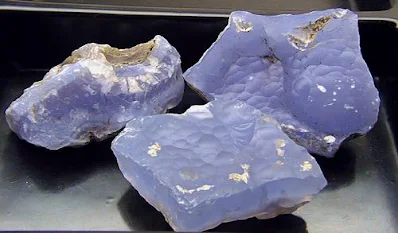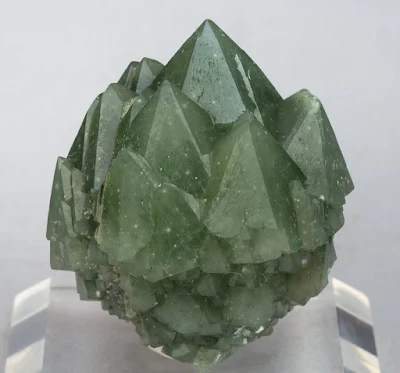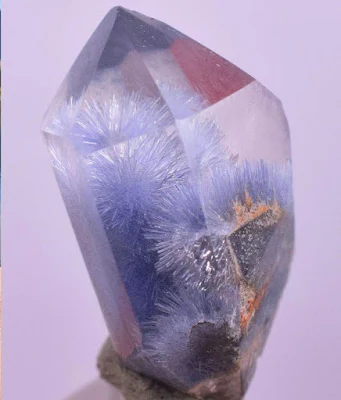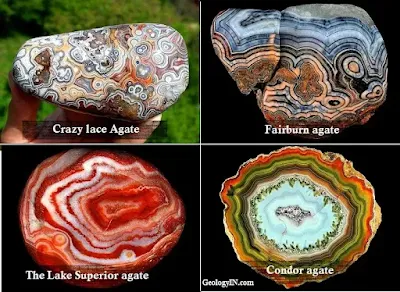Quartz: Types and Varieties of Quartz (Photos)
Quartz
Quartz is a hard, crystalline mineral composed of silicon dioxide (SiO₂). Quartz is one of the most common mineral on the face of the Earth. It is found in nearly every geological environment and is at least a component of almost every rock types: igneous, metamorphic, and sedimentary. It frequently is the primary mineral, >98%. It is also the most varied in terms of varieties, colors and forms.
The major varieties and types of quartz include rock crystal, amethyst, citrine, rose quartz, smoky quartz, ametrine, jasper, carnelian, and agate. These varieties of quartz are often used in jewelry and for ornamental purposes.
There are many different varieties of quartz, several of which are semi-precious gemstones. Since antiquity, varieties of quartz have been the most commonly used minerals in the making of jewelry and hardstone carvings, especially in Europe and the Middle East.
 |
| The Major Varieties of Quartz |
Some macrocrystalline (large crystal) varieties of quartz are well known and popular as ornamental stone and as gemstones.
- Amethyst is the purple gemstone variety.
- Citrine is a yellow to orange gemstone variety that is rare in nature but is often created by heating Amethyst.
- Milky Quartz is the cloudy white variety.
- Prasiolite is a leek-green gemstone variety that is rare in nature but is created by heating Amethyst from certain locations.
- Rose quartz is a pink to reddish pink variety.
- Smoky quartz is the brown to gray variety.
Cryptocrystalline (crystals too small to be seen even by a microscope) varieties are also used as semi-precious stones and for ornamental purposes. These varieties are divided more by character than by color.
The primary varieties of Cryptocrystalline quartz are as follows:
- Agate is a banded variety (sometimes with translucent bands)
- Bloodstone is green with red speckles
- Carnelian is yellow to orange
- Chrysoprase is green
- Flint is generally black with a fibrous microscopic structure
- Jasper is any colorful agate
- Onyx is black, white, or alternating black and white
- Sard is yellow to brown
- Sardonyx is banded, alternating sard and (usually white) onyx
Quartz Types and Varieties
Agate
Agate Multi-colored, banded chalcedony, semi-translucent to translucen. Although agates may be found in various kinds of rock, they are classically associated with volcanic rocks and can be common in certain metamorphic rocks.
Onyx
 |
| onyx contain bands of black and/or white. Copyright © Rob Lavinsky |
Onyx is a banded variety of chalcedony, which is a microcrystalline form of quartz. It is typically composed of alternating layers of black, white, or brown chalcedony. Onyx is a hard, opaque mineral with a waxy luster. It is used in a variety of jewelry and decorative objects.
Jasper
 |
| Rough of Kaleidoscope Jasper from Oregon |
Jasper is a type of chalcedony that is typically opaque and has a variety of colors and patterns. It can be found in solid colors, such as red, green, brown, and yellow, or it can be banded or have patterns. Jasper is a very common variety of quartz and is found in many parts of the world. It is often used for making beads, jewelry, and decorative objects.
Tiger's Eye
 |
| Polished tiger's eye gemstone |
Tiger's eye is a chatoyant gemstone that is usually a metamorphic rock with a golden to red-brown color and a silky lustre. As members of the quartz group, tiger's eye and the related blue-colored mineral hawk's eye gain their silky, lustrous appearance from the parallel intergrowth of quartz crystals and altered amphibole fibers that have mostly turned into limonite. It is a classic example of pseudomorphous replacement by silica of fibrous crocidolite (blue asbestos). An incompletely silicified blue variant is known as hawk's eye.
Aventurine translucent chalcedony with small inclusions (usually mica) that shimmer. The most common colour of aventurine is green, but it may also be orange, brown, yellow, blue, or gray. Chrome-bearing fuchsite (a variety of muscovite mica) is the classic inclusion, and gives a silvery green or blue sheen.
Amethyst
 |
| Amethyst Photo by @luminous.element |
Amethyst is the purple variety of quartz and is a popular gemstone. Amethyst is a semiprecious stone and is the traditional birthstone for February.
This mesmerizing color isn't inherent to the quartz itself, but rather arises from trace amounts of iron and other elements within the crystal structure. These impurities, along with natural irradiation, act like tiny filters, selectively absorbing specific wavelengths of light and leaving behind the enchanting purple hues we witness.
Rutilated Quartz
 |
| Quartz with Rutile inclusions from Novo Horizonte, Bahia, Northeast Region, Brazil Copyright © Rob Lavinsky |
Rutilated quartz is a type of quartz that contains acicular (needle-like) inclusions of rutile. It is used for gemstones. These inclusions mostly look golden, but they also can look silver, copper red or deep black. They can be distributed randomly or in bundles, which sometimes are arranged star-like, and they can be sparse or dense enough to make the quartz body nearly opaque. While otherwise inclusions often reduce the value of a crystal, rutilated quartz is valued for the quality and beauty of these inclusions.
Citrine
 |
| Giant Citrine faceted gem from Minas Gerais, Brazil. |
Citrine is a beautiful yellow or orange variety of quartz that is prized for its sunny colors and symbolism of abundance, prosperity, and optimism. Citrine's color ranges from pale yellow to brownish orange, with deeper saturated tones being more valuable. It's a popular choice for jewelry due to its affordability and vibrant color. Natural citrine is formed when silicon dioxide (SiO₂) crystals within quartz are infused with ferric iron (Fe³⁺) impurities. This process typically occurs during the crystal's growth or through natural heat exposure over extended periods. However, natural citrine is relatively rare. Most citrine on the market today (around 95%) is created through heat treatment of amethyst or smoky quartz.
Prasiolite
 |
Raw natural prasiolite
|
Prasiolite (or vermarine) is the name for any quartz crystal or cluster that is green in color.
While natural prasiolite exists, it's incredibly rare and typically has a very light, translucent green hue. Most of the prasiolite you'll encounter is created by heat-treating amethyst, which contains iron impurities. When exposed to temperatures around 500°C, the iron changes its oxidation state, transforming the amethyst's purple color into a range of leafy or yellowish greens.
Rose Quartz
 |
| Rose quartz |
Rose quartz a pink variety of quartz, is often used in jewelry and decorative objects due to its soft and delicate color. Its pink coloration is caused by trace amounts of titanium in the quartz crystal lattice. Titanium atoms within the quartz structure cause the absorption of certain wavelengths of light, primarily in the blue and green spectrum, while allowing red and orange wavelengths to pass through, resulting in the perceived pink hue.
While rose quartz deposits exist worldwide, Brazil, Madagascar, Sri Lanka, India, and the United States are notable sources. Throughout history, rose quartz has been imbued with powerful symbolism, particularly around love and relationships.
Rose quartz's captivating color and durability make it a popular choice for jewelry designers. It's crafted into rings, necklaces, earrings, and bracelets, adding a touch of elegance and symbolic meaning to any piece.
Milky Quartz
 |
Milky Quartz Cluster
|
Milky Quartz is any quartz crystal or cluster that is white in color and cloudy. The cloudy white character of the crystals is what lead to the variety name, milky. Milky quartz is the most common variety of crystalline quartz. The white color is caused by minute fluid inclusions of gas, liquid, or both, trapped during crystal formation, making it of little value for optical and quality gemstone applications
Smoky Quartz
 |
| Amazonite, Smoky Quartz with Goethite Onegite from Colorado, USA Photo : © Dorrisfamily |
Smoky quartz is the brown to black, and sometimes smoky gray version of quartz. It ranges in clarity from almost complete transparency to a brownish-gray crystal that is almost opaque. Smoky quartz, a variety itself of quartz, has a few varieties of its own. Read about it here.
Smoky quartz's smoky hues aren't caused by iron impurities, like citrine's yellow. Instead, natural radiation exposure is the key player. When quartz crystals are exposed to radiation from surrounding rocks or cosmic rays, it creates color centers within the crystal lattice. These color centers are responsible for the smoky gray to brownish-black shades we see.
Carnelian
 |
| Polished Carnelian |
Carnelian is a red or orange variety of chalcedony that is often used in jewelry and decorative objects. The red or orange color is caused by trace amounts of iron in the quartz crystal lattice. Carnelian is found in many parts of the world, but the most famous source is India. Carnelian is often associated with vitality and creativity. Similar to carnelian is sard, which is generally harder and darker.
Chalcedony
 |
| Chalcedony |
Chalcedony is a cryptocrystalline quartz and moganite mixture. The term is generally only used for white or lightly colored material. Otherwise more specific names are used. Chalcedony has a waxy luster, and may be semitransparent or translucent. It can assume a wide range of colors, but those most commonly seen are white to gray, grayish-blue or a shade of brown ranging from pale to nearly black.
Mtorolite
 |
| Mtorolite zimbabwe |
Mtorolite is a rare variety of microcrystalline quartz. Its stunning emerald green color comes from trace amounts of chromium minerals. Found primarily in Zimbabwe near Mtoroshanga (hence the name!), it exists in limited quantities, adding to its allure.
Chrysoprase
 |
| (chrysoprase). An amazing new find from Australia. Photo by: Australian Outback Mining |
Chrysoprase is a green variety of chalcedony, which has been colored by nickel oxide. Its color is normally apple-green, but varies to deep green. Chrysoprase is cryptocrystalline, which means that it is composed of crystals so fine that they cannot be seen as distinct particles under normal magnification.
Heliotrope - Bloodstone
 |
Heliotrope photo courtesy of R. Weller
|
Heliotrope, also known as bloodstone, is an opaque, dark green variety of chalcedony with red inclusions of hematite. The name "heliotrope" is derived from the Greek words helios, meaning "sun," and tropein, meaning "to turn." This refers to the red reflection seen when the gemstone is turned to face the sun while immersed in water.
Ferruginous Quartz
 |
| Ferruginous Quartz - red quartz |
Ferruginous Quartz is a type of quartz that contains iron oxide inclusions, giving it a rusty or reddish-brown color. The iron content can create interesting patterns and inclusions within the quartz crystals. Ferruginous Quartz is found in many parts of the world, including Brazil, Madagascar, and the United States. Ferruginous quartz is used in jewelry and other decorative objects.
Prase Quartz
 |
| Prase Quartz - green quartz |
Prase Quartz is a green variety of quartz, and its color is attributed to the presence of actinolite or chlorite inclusions. The green hue can range from light to dark green, and the inclusions often create unique patterns. The name "prase" is derived from the Greek word for leek, referring to the green color. It is found in many parts of the world, including Germany, Australia, and the United States. Prase quartz is used in jewelry and other decorative objects.
 |
| Dumortierite Quartz |
Dumortierite Quartz is a type of quartz that contains inclusions of dumortierite, a blue mineral. The blue color can vary from light to dark blue, and the inclusions often form fibrous or needle-like structures within the quartz crystals. It is found in only a few places in the world, including Brazil, Namibia, and Madagascar. Dumortierite quartz is used in jewelry and other decorative objects.
Conclusion
All these varieties of quartz are appreciated in the world of mineral and crystal enthusiasts for their unique colors, inclusions, and visual appeal. Each type has its own geological origin and formation process, contributing to the diversity of quartz specimens found in nature.



%20(1).webp)






